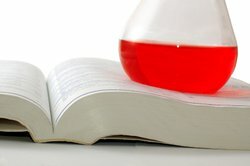Reaction of acetic acid with water and sodium hydroxide
The reaction of an acid, for example acetic acid, with sodium hydroxide is known in chemistry as neutralization. However, it makes sense to carry out this reaction in the presence of water. But why and how should one proceed exactly?

What you need:
- acetic acid
- water
- Sodium hydroxide
- Indicator such as B. Phenolphthalein
- Glass rod
- Beakers
- thermometer
- Protective clothing
Experimental instructions for the neutralization of acetic acid with NaOH
- Put on your protective clothing. To do this, you should tie back longer hair and put on a protective gown, as the starting materials used are highly caustic. This is also the reason why you should put on protective glasses and use protective gloves.
- Now put enough water in a beaker so that it is no more than 1/4 full. Then add about half as much acetic acid to the water while stirring with the glass rod.
- To see whether the reaction is complete and the acetic acid has been neutralized with sodium hydroxide, add a few drops of an indicator to the aqueous acetic acid solution. Phenolphthalein would be suitable, but methyl red or litmus would also be suitable.
- Fill a second beaker of the same size with the same amount of water and add solid sodium hydroxide while stirring continuously until it no longer dissolves. This is how you get a highly concentrated sodium hydroxide solution. If the solution heats up too much, wait some time for it to cool down.
- When both the acetic acid solution and the sodium hydroxide solution have cooled to room temperature, very slowly add the sodium hydroxide solution to the acid solution while stirring. You can check the temperature change with a thermometer.
- As soon as the indicator has constantly changed color, the neutralization of the acid is complete and there is an excess of the lye.
Neutralize caustic soda - this is how it works with food acids
In theory, you can neutralize any lye with any acid. The neutralization ...
Explanation of the reaction in the water
- As a school experiment, the neutralization of acetic acid should only take place with water as a diluent. On the one hand, the educts are less dangerous in diluted form. On the other hand, the reaction does not occur quite as quickly and the resulting heat is given off to a larger volume of liquid. This means that the solution does not heat up as much and burns and accidents due to unexpected heat generation can be avoided.
- The neutralization can easily be explained with the following reaction equation:
C.2H4O2 + NaOH → H2O + NaC2H3O2 . Acetic acid and sodium hydroxide thus become water and sodium acetate.
How helpful do you find this article?


